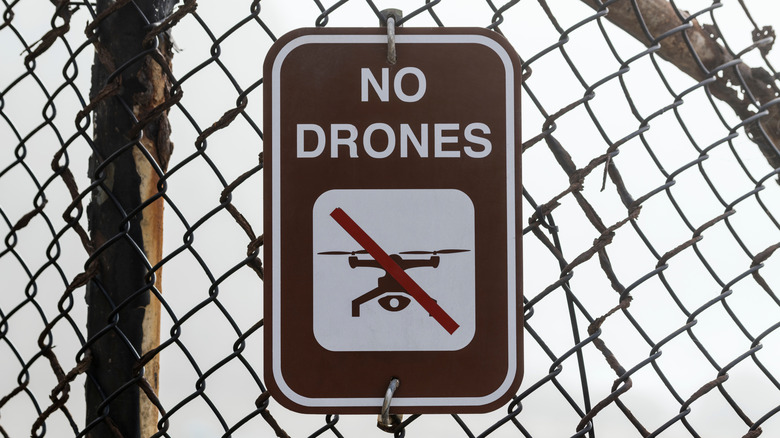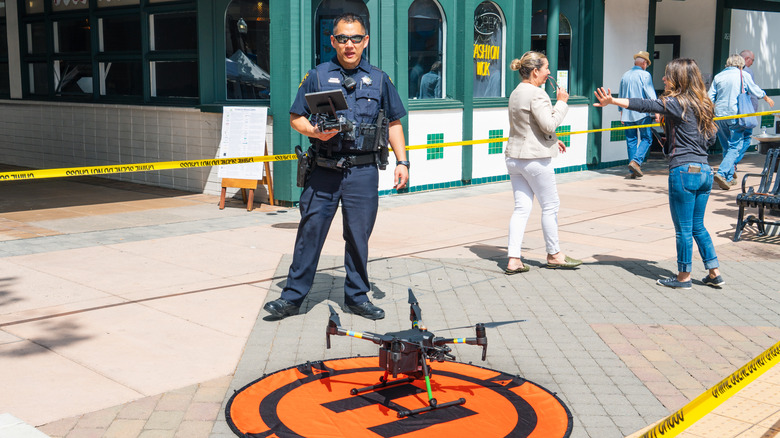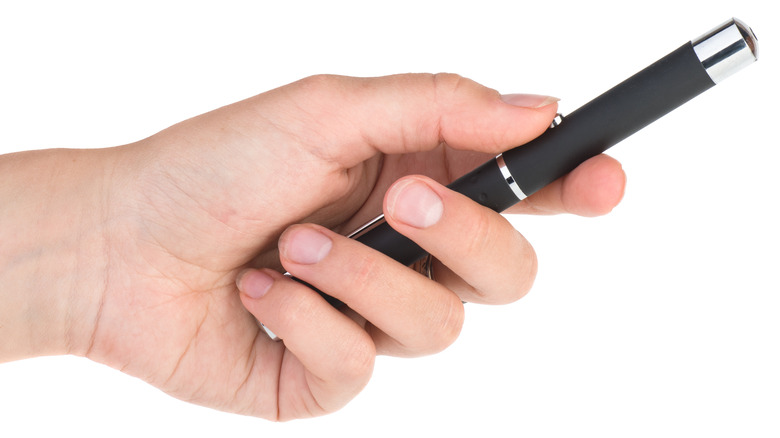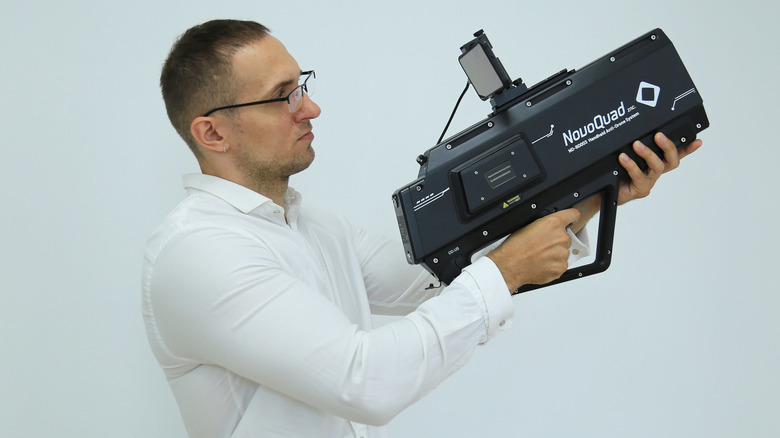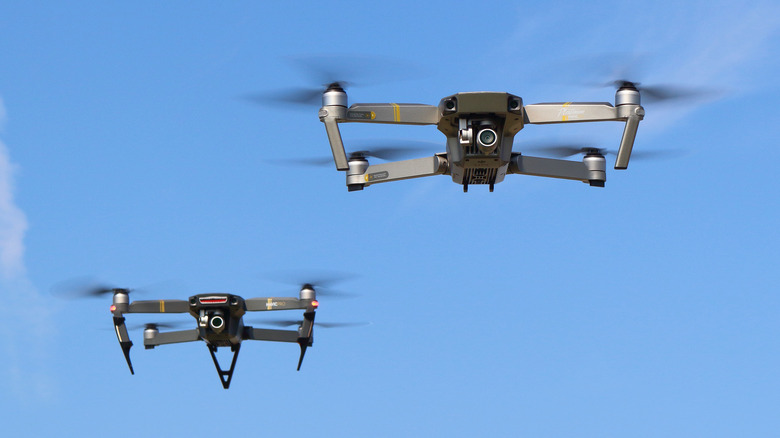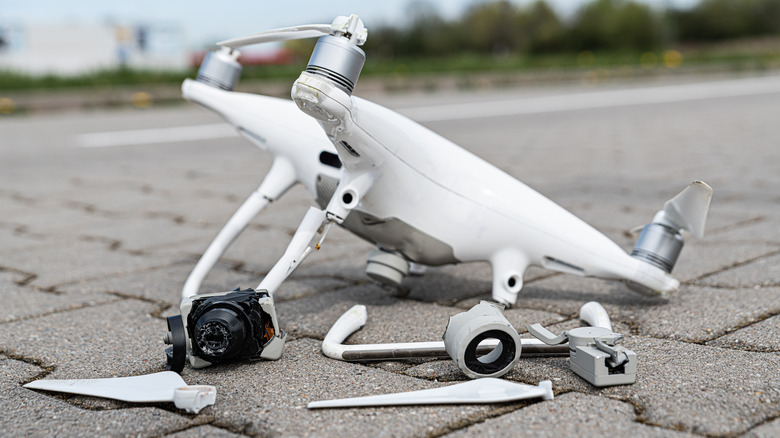The 5 Best Ways To Stop A Drone
Private and commercially owned drones are pretty much everywhere these days and are being used (or will be used) for everything from photography to package delivery. But what if one of these drones needs to be taken down — literally? Well, there are a number of ways to stop a pesky drone no matter the reason behind its presence. However, it's extremely important to note that in the U.S., you could be on the hook for damaging a drone and may face stiff legal and/or financial penalties.
That's the case even if a drone is flying over your house without your prior knowledge or consent. So, if a nearby drone does start bothering you or otherwise causing trouble, it may be best not to take matters into your own hands. With that said, there are still some options for dealing with the little buggers, assuming the situation truly calls for intervention. The main thing to keep in mind is that any method that could potentially cause damage is very much at your own risk and that it's important to know your local laws and regulations before you attempt to interfere with a flying drone.
5. Notify the authorities
The least complicated — and probably least expensive — way to deal with a troublesome drone is to file a complaint with the Federal Aviation Administration (FAA). If somebody's using a drone to do something illegal, possibly immoral, or that could pose a danger to others, you can report the incident to the FAA and let the agency handle it.
That said, a slightly more immediate approach would be to contact members of law enforcement who have FAA connections. Officers in the FAA's Law Enforcement Assistant Program (LEAP) should have knowledge of what drones are and aren't allowed to do, and can act more quickly than filing government paperwork. While it still won't lead to immediate action, things will likely get moving a bit faster than your other option.
Either option may not be ideal if a drone is bothering you right now, but leaving matters up to the proper authorities means you won't have to worry about whether you'll end up in court over breaking an expensive remote-controlled toy. Please be aware that all of the other actions beyond this one are not recommended, and that taking matters into your own hands rather than contacting the proper authorities comes with various risks and potential legal consequences.
4. Lasers
A more direct option, which would require at most spending a few dollars at an electronics store (or possibly a pet store), is to shine a laser at the drone. Keep in mind, however, that doing this can be very dangerous in certain circumstances and is also illegal. Shining a laser at a drone could impede or disrupt the pilot's vision, which would annoy them at best but at worst could cause serious problems.
If the pilot were to lose control of the drone due to an inability to see clearly, the drone could crash. Depending on its location, that crash could damage the drone, damage someone's property, and even injure somebody. Another risk with using a laser is possibly aiming at aircraft that could be flying overhead. Even if you're aiming at a drone — assuming a plane is situated somewhere behind it — that beam could end up distracting the plane's pilot instead. That's both incredibly dangerous and super illegal. Hitting an aircraft with a laser would result in the pilot reporting the incident, which would trigger an investigation that could result in being arrested.
3. Set up a signal jammer
Signal jammers are also an option, and there are some designed specifically to disrupt drone signals, including the NovoQuad. The problem is that while jammers may be a safer alternative to laser pointers as there's much less risk of catching flying aircraft in the crossfire, that doesn't make them a better solution. To put it bluntly, signal jammers are illegal – even if you can find one for purchase.
For that reason alone it's not recommended, but it also poses safety risks since the effect is spread out over a set area rather than targeted to just one spot. Using a signal jammer could prevent other forms of communication from working properly, including internet connections and even emergency calls. As irritating as a nosy drone might be, knocking out the ability for essential emergency services to work properly is a much bigger problem, and the repercussions could include anything from a hefty fine to jail time.
2. Fight fire with fire
If you're looking to give intrusive drone pilots a taste of their own medicine, you could also try to use your own drone to trap the offending drone in a net – theoretically, at least. While trapping a drone with another drone reduces the risk (since it's caught in a net and then flown back down rather than crashing), there is still the potential for breaking the captured drone, which could result in other problems for you.
The possible damage liability aside, you'd also have to already own (or spend the money on) a drone big and sturdy enough to be able to carry other drones. As well, you'd have to figure out how to get it to safely drop a net in the first place, as the methods are still being looked into by researchers. Even more concerning is that if the system doesn't work correctly, you could end up with two out-of-control drones leading to additional damage or causing injuries.
1. Literally shoot a net at it
If all else fails (though it shouldn't, and this method could still get you in trouble), you can always try to launch a net at a bothersome drone to pull it out of the sky using something like the Skywall system. It's a pretty straightforward solution, but it comes with several caveats. It's not the kind of thing you can buy during a typical trip to a store, for one thing, and it's not easy to get ahold of one of these net cannons (it may not even be available for consumers at all). Even if it was possible to easily buy an anti-drone net launcher, it likely wouldn't be cheap. This method also doesn't alleviate the problem of causing damage to the targeted drone.
In the case of the Skywall drone capture system, an attached parachute greatly reduces the risk of an out-of-control crash causing significant damage or harm, but the captured drone could still sustain breakage. Soft landing or not, getting a net tangled up in all the rotors could snap a propeller or two or strain the motors. Assuming you did this, there's a good chance you'd damage the drone and possibly face legal consequences, not to mention the risk that comes with accidentally launching the net beyond the drone.
